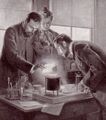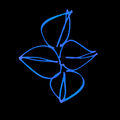Template:Selected anniversaries/December 26: Difference between revisions
No edit summary |
No edit summary |
||
| Line 8: | Line 8: | ||
||1827: Étienne Léopold Trouvelot born ... artist, astronomer and amateur entomologist. He is noted for the import and release of the gypsy moth into North America. Pic. Drawings: http://www.huntington.org/WebAssets/Templates/exhibitiondetail.aspx?id=25040 http://www.graphicine.com/etienne-trouvelot-astronomical-drawings/ | ||1827: Étienne Léopold Trouvelot born ... artist, astronomer and amateur entomologist. He is noted for the import and release of the gypsy moth into North America. Pic. Drawings: http://www.huntington.org/WebAssets/Templates/exhibitiondetail.aspx?id=25040 http://www.graphicine.com/etienne-trouvelot-astronomical-drawings/ | ||
||1837: Martin(us) van Marum born ... physician, inventor, scientist and teacher, who studied medicine and philosophy in Groningen. Van Marum introduced modern chemistry in the Netherlands after the theories of Lavoisier, and several scientific applications for general use. He became famous for his demonstrations with instruments, most notable the Large electricity machine, to show statical electricity and chemical experiments while curator for the Teylers Museum. | ||1837: Martin(us) van Marum born ... physician, inventor, scientist and teacher, who studied medicine and philosophy in Groningen. Van Marum introduced modern chemistry in the Netherlands after the theories of Lavoisier, and several scientific applications for general use. He became famous for his demonstrations with instruments, most notable the Large electricity machine, to show statical electricity and chemical experiments while curator for the Teylers Museum. Pic. | ||
||1861: Emil Johann Wiechert born ... physicist and geophysicist who made many contributions to both fields, including presenting the first verifiable model of a layered structure of the Earth and being among the first to discover the electron. | ||1861: Emil Johann Wiechert born ... physicist and geophysicist who made many contributions to both fields, including presenting the first verifiable model of a layered structure of the Earth and being among the first to discover the electron. Pic. | ||
||1862: The largest mass-hanging in U.S. history took place in Mankato, Minnesota, 38 Native Americans died. | ||1862: The largest mass-hanging in U.S. history took place in Mankato, Minnesota, 38 Native Americans died. | ||
||1869: Jean Léonard Marie Poiseuille dies ... physicist and physiologist. He experimentally derived, and in 1840 and 1846 formulated and published, Poiseuille's law (now commonly known as the Hagen–Poiseuille equation, crediting Gotthilf Hagen as well), which applies to laminar flow, that is, non-turbulent flow of liquids through pipes of uniform section, such as blood flow in capillaries and veins. Pic. | |||
||1889: Jenő Hunyady dies ... mathematician noted for his work on conic sections and linear algebra, specifically on determinants. Pic. | ||1889: Jenő Hunyady dies ... mathematician noted for his work on conic sections and linear algebra, specifically on determinants. Pic. | ||
Revision as of 11:30, 10 January 2019
1791: Polymath Charles Babbage born. He will construct mechanical computers which anticipate the concept of programmable digital computers.
1896: Physician and physiologist Emil du Bois-Reymond dies. He discovered nerve action potential, and developed experimental electrophysiology.
1898: Marie and Pierre Curie announce the isolation of radium.
1899: Engineer and crime-fighter Gustave Eiffel uses Gnomon algorithm techniques to detect and prevent crimes against physics.
2006: Physicist and mathematician Martin David Kruskal dies. He made fundamental contributions in many areas of mathematics and science, including the discovery and theory of solitons.
2016: Survey data reveals widespread Scrimshaw binging the day after Christmas.
2017: Steganographic analysis of Blue Foliage 2 unexpectedly reveals "at least five kilobytes" of encrypted data.






